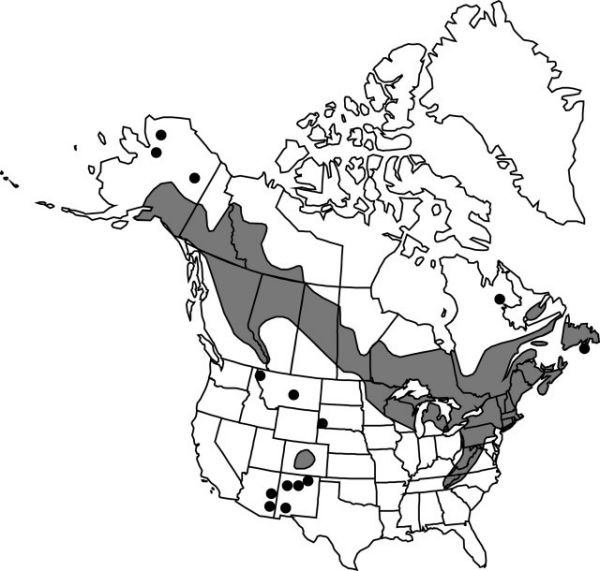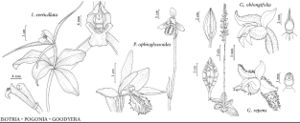Goodyera repens
in W. Aiton and W. T. Aiton, Hortus Kew. 5: 198. 1813.
Leaves: blade uniformly green or with green lateral veins bordered by white or greenish white tissue, narrowly to broadly ovate, 1.1–3.2 × 0.5–1.8 cm, apex acute or obtuse. Inflorescences secund, infrequently loosely spiraled, 7–36-flowered; peduncle 3–18 cm. Flowers: lateral sepals 3–5.2 mm; petals distinct; hood 3–5.5 mm; lip narrowly saccate, lanceolate, 1.8–4.8 × 1.4–3.2 mm, apex acute, recurved or reflexed, inner surface with 2 or 4 glandular ridges; anther inflexed, not immersed in shallowly concave clinandrium, apex apiculate; pollinia blunt; rostellar beak 2-pronged, 0.2–0.6 mm, shorter than body of stigma; viscidium orbiculate. 2n = 30.
Phenology: Flowering early Jul–early Sep.
Habitat: Shady, moist, coniferous or mixed woods, on mossy or humus-covered ground, sometimes in bogs or cedar swamps
Elevation: 0–2900 m
Distribution

St. Pierre and Miquelon, Alta., B.C., Man., N.B., Nfld. and Labr., N.W.T., N.S., Ont., P.E.I., Que., Sask., Yukon, Alaska, Ariz., Colo., Conn., Maine, Md., Mass., Mich., Minn., Mont., N.H., N.Mex., N.Y., N.C., Pa., S.Dak., Tenn., Vt., Va., W.Va., Wis., Eurasia.
Discussion
Two varieties of Goodyera repens have been recognized: individuals with plain green leaves as var. repens and those with leaf veins bordered by broad white bands as var. ophioides Fernald. Many specimens from western North America are intermediate in this character: the bands bordering the veins are extremely narrow and almost indistinguishable by color from the leaf blade proper. Most specimens from eastern North America have obviously white-reticulate leaves, and most specimens from western Canada have plain green leaves (some with darker green veins). At several localities in western North America, plants with plain green leaves and plants with faintly reticulate leaves are found together (W. J. Cody 1961). Individuals with faintly reticulate leaves and those with plain green leaves are often found on the same herbarium sheet and, infrequently, both kinds of leaves occur on the same plant. Because of this variation in the degree of white reticulation, the varieties are not recognized here. Individuals with plain green leaves, obviously white-reticulate leaves, and intermediate leaves occur in Alaska.
Selected References
None.
